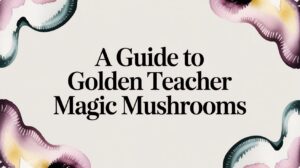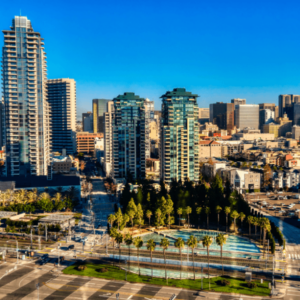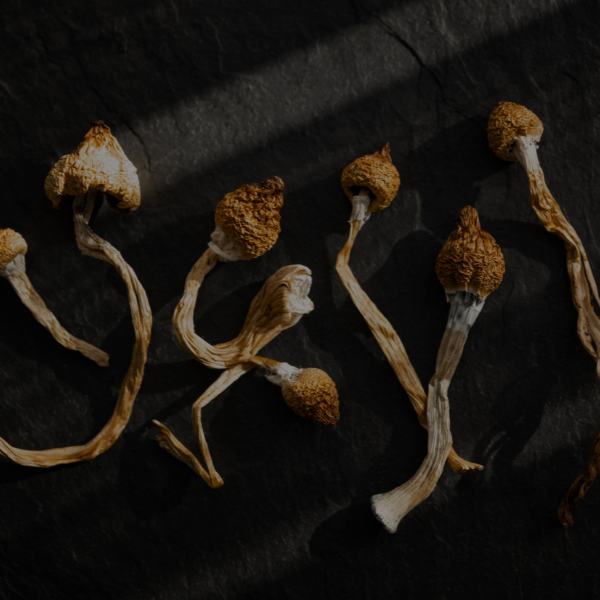So, you’re interested in finding mushrooms. You’ve got two main trails you can follow: foraging for them in the wild or buying them from people who know what they're doing. Heading out into nature gives you a direct connection to the source, but it absolutely demands that you know your stuff. Buying, on the other hand, is all about safety and convenience.
Think of this as your starting point, no matter which path you choose. We'll cover everything you need to know to get started.
Your Mushroom Finding Adventure Starts Here
The hunt for mushrooms is an ancient practice, a cool mix of science, nature, and a bit of good old-fashioned detective work. Whether you're picturing yourself harvesting gourmet chanterelles from a misty forest floor or you just want a reliable hookup for high-quality fungi, figuring out your options is the first step. This isn't just about finding mushrooms—it's about doing it safely, ethically, and with total confidence.
This guide is built to give you a clear path, whether you're a complete beginner or have a little experience under your belt. We’ll dig into the critical skills you need for foraging and point you toward the best alternatives if you'd rather leave it to the pros.
Adventure vs. Safety: Finding the Right Balance
Let's be real—the romance of mushroom foraging is hard to ignore. It’s a huge hobby in places like Europe and North America, where people are constantly on the lookout for prized species. In the U.S. alone, it's estimated that over 100,000 people get out there and forage for mushrooms every year, joining clubs and taking guided tours to fuel their passion. You can find more stats on the growing mushroom market over at The Business Research Company.
But this adventure comes with one non-negotiable rule: you have to be obsessed with safety. The difference between a delicious meal and a trip to the emergency room can be razor-thin, which means you need to be 100% certain of what you're picking.
The most important rule of the woods is simple: "When in doubt, throw it out." This isn't just a friendly suggestion; it's a life-saving mantra every single forager needs to live by. No exceptions.
What We're Going to Cover
To help you get your bearings in this exciting world, we're going to walk through every essential piece of the puzzle. This is your foundation—the knowledge you need to make smart, safe decisions from here on out.
Here’s a quick look at what’s ahead:
- Forage or Buy? We'll break down the pros and cons to help you figure out which route makes the most sense for you.
- Safe Identification 101: We'll cover the core principles of identifying mushrooms, including key features to look for and dangerous look-alikes to avoid at all costs.
- The Right Gear & Techniques: Get the rundown on the tools you’ll need and the proper, ethical way to harvest.
- Reading the Environment: Learn how to use seasons and habitats as your guide to predict where and when mushrooms will pop up.
- Trusted Alternatives: If foraging isn't for you, we'll guide you on how to buy from reputable vendors for guaranteed quality and safety, including awesome options like our magic mushroom gummies and chocolates.
By the time you're done with this guide, you won't be wondering "how to find mushrooms" anymore. Instead, you'll have the confidence to get started on your own journey, responsibly.
Choosing Your Path: Foraging vs. Buying
The very first decision you'll make on your mushroom journey has nothing to do with identifying gills or taking a spore print. It’s much more fundamental: are you going to find them yourself or buy them from a trusted source? This choice really sets the stage for everything that comes next, shaping your whole experience, the level of risk you're comfortable with, and the skills you'll need.
For a lot of people, the pull of foraging is strong. It's a genuinely immersive experience, connecting you directly with nature and turning a simple walk in the woods into a legitimate treasure hunt. There’s a deep, almost primal satisfaction that comes from finding your own mushrooms, learning their habitats, and understanding the subtle cues of the forest. It’s a path for the self-reliant and the curious.
But that romantic idea comes with a serious dose of reality. Foraging has a steep learning curve and involves very real risks. The line between an edible prize and a toxic look-alike can be razor-thin, and you need 100% certainty in your identification skills. This isn't a casual hobby; it's a pursuit that demands patience, meticulous study, and a healthy respect for the dangers involved.
The Appeal of Buying From Experts
On the other side of the coin, you have the option of buying from a trusted vendor. This path is all about safety, convenience, and guaranteed quality. When you purchase from a reputable source, you completely eliminate the guesswork and the risk of a dangerous misidentification. Products are often lab-tested for potency and purity, so you know exactly what you're getting, every single time.
This approach gives you access to a huge variety of mushrooms that might not grow anywhere near you, and they're available year-round, not just when the season is right. It’s the perfect option for anyone who wants the benefits of mushrooms without the massive time commitment and inherent risks of hunting for them in the wild. Sure, it costs money, but for many, the peace of mind is worth every penny.
Choosing to buy mushrooms isn't a lesser path—it's a smart, calculated decision that prioritizes safety and reliability. It lets you focus on the experience itself, not the potential pitfalls of identification.
Foraging vs. Buying Mushrooms: A Quick Comparison
So, how do you decide which path is right for you? To help you figure it out, let’s break down the key differences. Be honest with yourself about your personal risk tolerance, how much time you're willing to invest, and what you're ultimately hoping to get out of the experience.
| Factor | Foraging (Wild) | Buying (Vendors) |
|---|---|---|
| Safety & Risk | High risk; requires expert knowledge for safe identification. Mistakes can be dangerous. | Extremely low risk; products are vetted, often lab-tested, and guaranteed to be safe. |
| Cost | Low monetary cost (free), but high investment in time, learning, and gear. | Higher monetary cost, but saves significant time and removes the need for expertise. |
| Convenience | Low convenience; requires travel, specific weather conditions, and seasonal timing. | High convenience; available year-round with discreet, fast shipping directly to you. |
| Variety | Limited to what grows locally and seasonally in your specific region. | Access to a wide and consistent variety of species from different regions. |
| Learning Curve | Very steep; involves learning mycology, ecology, and plant identification. | Minimal; requires only basic product knowledge to choose what's right for you. |
| Experience | An immersive, hands-on outdoor adventure that connects you with nature. | A straightforward, reliable process focused on accessing a quality product. |
Looking at it side-by-side makes the trade-offs pretty clear. One path offers adventure and self-sufficiency, while the other provides safety and convenience. Neither is inherently better—it all comes down to what fits your lifestyle and priorities.
Finding a Middle Ground
It's also worth remembering that these two paths aren't mutually exclusive. Plenty of people enjoy the thrill of foraging for well-known culinary mushrooms while relying on trusted vendors for their specific psychedelic needs.
You might even find that foraging sparks a deeper interest in cultivation. For those who are curious about a more hands-on approach without the risks of wild harvesting, exploring a magic mushroom growing kit can be a fantastic way to learn about the fungal life cycle in a controlled, safe environment.
Ultimately, the best way to source your mushrooms is the one that feels right and, most importantly, safe for you. Weighing these factors honestly will get your journey started on the right foot, with confidence and a clear understanding of the road ahead.
Mastering Safe Mushroom Identification
So, you've weighed the thrill of the hunt against the convenience of buying, and the call of the wild won out. Great. Now comes the most important part of your entire foraging journey, and I can't stress this enough: when it comes to identifying mushrooms, absolute certainty is the only rule.
This isn't a hobby where you can afford to be "pretty sure." It’s a practice that demands respect, patience, and a healthy dose of humility. Thinking you know what you’ve found isn’t good enough—you have to know.
A common rookie mistake is snapping a picture, plugging it into an app, and calling it a day. While field guides and apps are fantastic tools, they’re just one piece of the puzzle. To confidently identify a mushroom, you have to play detective, examining every single clue before reaching a verdict. It’s about much more than just the color of the cap.

Beyond a Quick Glance: The Anatomy of a Mushroom
Getting a positive ID means looking at the whole picture. You need to become familiar with a mushroom's anatomy, and a positive identification requires checking off multiple boxes, not just one or two.
- Cap (Pileus): Don't just look at the color. What’s the shape—is it bell-shaped, flat, or wavy? And the texture—is it slimy, smooth, or scaly? These details can be the deciding factor between two very different species.
- Gills (Lamellae): Flip that cap over. How do the gills connect to the stem? Do they run down it, or are they completely free? Notice their spacing, too. Are they packed tight or spread far apart? Gill color is another huge clue.
- Stem (Stipe): Check out the stem. Is it hollow or solid? Does it have a ring (the annulus) around it? Most importantly, is there a sac-like cup (the volva) at the base, sometimes buried just under the soil? A volva is a massive warning sign, as it’s a key feature of the deadly Amanita family.
- Spore Print: For beginners, this is non-negotiable. It's one of the most reliable ID features there is. Just slice off the cap, place it gills-down on a piece of paper (half-white, half-black works best), and cover it with a glass for a few hours. The color of the spores that drop is a definitive trait.
My personal mantra has always been simple: "When in doubt, throw it out." Seriously. No mushroom is worth the risk to your health. It’s the golden rule of foraging for a reason.
Red Flags and Devious Doppelgangers
The mushroom world is full of tricksters. For nearly every delicious edible, there’s a poisonous look-alike ready to fool an untrained eye. Your safety hinges on your ability to spot these impostors.
Take the famous chanterelle. It’s often confused with the toxic Jack-O'-Lantern mushroom. They’re both orange, sure, but the chanterelle has blunt, vein-like ridges that run down its stem, not the true, sharp-edged gills of the Jack-O'-Lantern. It’s a subtle difference that can save you from a world of hurt.
Another classic mix-up is the Aborted Entoloma, affectionately known as "Shrimp of the Woods." This strange, lumpy mushroom often grows right next to its toxic, gilled relatives. This is a perfect example of why it's not enough to identify one mushroom; you have to understand its habitat and who its neighbors are.
The Unspoken Rule: Learn From a Pro
Books and websites are indispensable, but they're no substitute for hands-on experience with a seasoned mentor. The absolute safest way to learn is by foraging with someone who knows their stuff. An expert can point out subtle clues and nuances that a photo could never capture.
Joining a local mycological society is one of the best moves you can make as a beginner. These groups host guided forays and workshops, connecting you with a community of experts who are passionate about sharing their knowledge safely. Learning to forage is a journey, not a race. Take your time, double- and triple-check every find, and never, ever eat anything unless you are 100% certain of what it is.
Your Foraging Toolkit: Gear and Techniques
A successful day of foraging comes down to preparation, not just blind luck. Knowing what to look for is only half the battle; having the right tools and using the right techniques is what separates a safe, sustainable harvest from a disappointing one. Just grabbing a plastic bag and heading into the woods is a recipe for crushed, sweaty mushrooms that are nearly impossible to identify later.
Building a proper toolkit is the first real step toward becoming a responsible forager. Think of it like gearing up for any other serious outdoor hobby—every single item has a specific and important job to do.
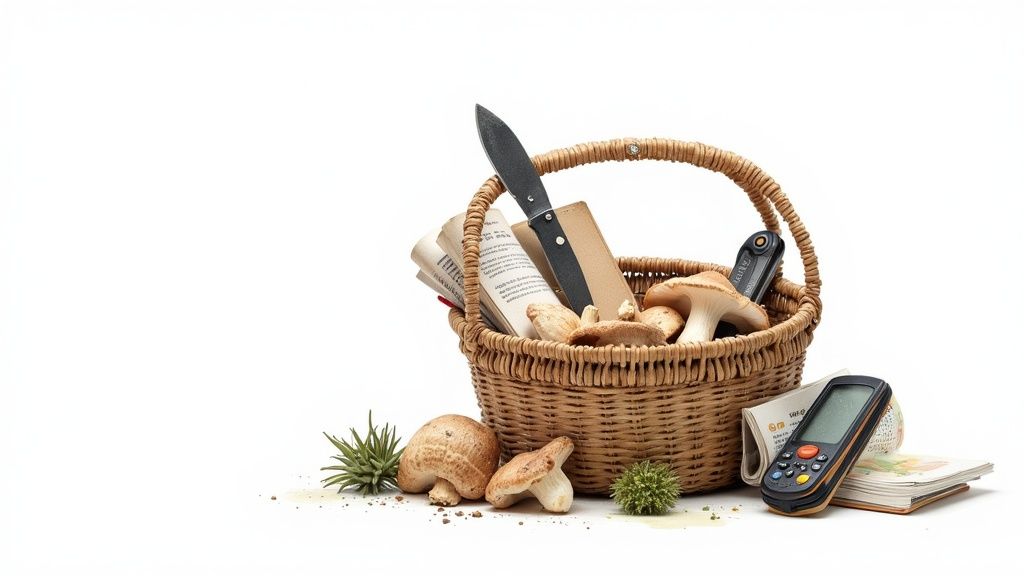
Essential Gear for Every Forager
You don't need a ton of expensive equipment to get started, but a few key items will make a world of difference in your experience and success rate. These tools help you collect, inspect, and carry your finds without damaging them or the local environment.
A Wicker Basket or Mesh Bag: This is non-negotiable. Plastic bags are a mushroom's worst enemy—they trap moisture and heat, turning your beautiful finds into a mushy, unrecognizable mess. Baskets and mesh bags let air circulate, keeping everything fresh. As an added bonus, they allow spores to drop back to the forest floor as you walk, helping to seed future mushroom patches.
A Foraging Knife: A dedicated knife, often with a curved blade, is perfect for cleanly slicing mushrooms at the stem. Many purpose-built foraging knives also come with a small brush on the other end, which is incredibly handy for whisking away dirt and debris right there in the field. Less mess to clean up at home!
Reliable Field Guides: Notice that's guides, plural. You should never, ever rely on just a single source for identification. A good regional guidebook is your primary tool, but you always want to cross-reference it with another book or a trusted online resource to be absolutely certain of what you've found.
Magnifying Glass or Jeweler's Loupe: So many of the critical features you need to see for a positive ID—like the texture of a stem or the pattern on the gills—are incredibly tiny. A small magnifying glass lets you get up close and personal with these details. It can easily be the deciding factor between two very similar-looking species.
Navigation Tools: Whether you prefer a dedicated GPS, your phone with offline maps downloaded, or an old-school compass and map, never venture into the woods without a reliable way to get back out. It’s surprisingly easy to get turned around when your eyes are glued to the ground looking for treasures.
Harvesting Techniques for Sustainability
How you pick a mushroom matters just as much as what you pick. If you do it right, you ensure the underlying mycelial network—the real organism—stays healthy and productive for seasons to come. Your goal should be to act as a steward of the forest, not just someone taking from it.
The most widely accepted method is to cut the mushroom at the base of its stem with your knife. This leaves the "roots" (the mycelium) undisturbed in the soil and also keeps your harvest much cleaner. While some foragers like to twist and pull to see the base for identification purposes, cutting is generally seen as the best practice for preserving the patch.
Respect for the environment is the cornerstone of ethical foraging. The goal isn't just to find mushrooms for yourself today, but to ensure they continue to thrive for others—and for the ecosystem—tomorrow.
Documenting your finds is another crucial technique, especially when you're starting out. Before you even think about picking it, take clear photos of the mushroom from every angle: top, side, and underneath showing the gills. Make sure to get a shot of it in its natural habitat, too—the types of trees or soil nearby are often vital clues for identification.
The Unspoken Rules of the Woods
Beyond the gear and the harvesting methods, a true forager lives by an ethical code. These are the practices that keep the woods a healthy, vibrant resource for everyone and everything that depends on them. This is where you shift from simply taking things to actively participating in the ecosystem.
In the United States, there are approximately 6,000 reported cases of mushroom poisoning each year, with a small but tragic number of those resulting in fatalities. Even with these risks, the allure of wild mushrooms draws in new people every year, supported by great field guides and communities that promote safe, ethical practices. You can learn more about the growing interest in mushrooms at The Business Research Company.
Always be mindful of property lines. Know if you’re on public or private land, and always get permission if it's required. Practice "Leave No Trace" principles by packing out absolutely everything you bring in with you.
And finally, never overharvest. A good rule of thumb is to take no more than one-third of what you find in any given patch. Leave plenty for wildlife and for the mushrooms to complete their life cycle and spread their spores for next year.
Finding Mushrooms: Where and When to Look
If you want to get good at finding mushrooms, you have to start thinking like one. Foraging success isn't just about wandering through the woods and hoping for the best. It’s about learning to read the landscape, understanding the rhythm of the seasons, and knowing exactly where to focus your energy. This shift in mindset turns a casual walk into a productive hunt and seriously boosts your chances of a great find.
Mushrooms don't just appear out of nowhere. Their arrival is a carefully timed event, triggered by a perfect mix of moisture, temperature, and food. The forest floor is a complex world of relationships, and fungi are right at the center of it. Get a handle on these connections, and you've unlocked the secret to a successful forage.
Learn to Read the Landscape
Different mushrooms have different tastes in real estate. Some love the damp, shady floors of hardwood forests, while others pop up in sunny fields or freshly disturbed soil. Your first job is to learn what these prime habitats look like.
- Deciduous Forests: Hardwood forests packed with oak, beech, and maple trees are total hotspots. The leaves overhead keep the ground moist and cool, and the decaying leaf litter is a non-stop buffet for fungi.
- Coniferous Forests: Pine, fir, and spruce forests create a more acidic soil, which certain species absolutely love. Keep your eyes peeled for mushrooms growing right out of the thick carpet of pine needles.
- Open Fields and Pastures: Don't forget about open spaces. Some mushrooms, especially those that feast on decaying grass roots or dung, thrive in sunny pastures. These spots can be incredibly productive after a good, soaking rain.
The best foragers I know don't just look for mushrooms; they look for the right conditions. A certain kind of tree, a mossy bank by a creek, or even the way a hill slopes can all be signs that you’re in the right spot.
The Crucial Role of Symbiotic Relationships
So many of the mushrooms we love to find are in a deep, symbiotic relationship with specific trees. This partnership is called mycorrhiza, and it's a two-way street: the fungus helps the tree suck up water and nutrients from the soil, and the tree pays it back with sugars. Find the right tree, and you'll often find the mushroom.
Morels, for instance, are famously linked to dying elm trees, but you can also spot them near ash, poplar, and in old apple orchards. Chanterelles, another crowd favorite, often hang out with oak trees. Learning these specific tree-mushroom pairings is like getting a treasure map to the forest.
This knowledge gets even more powerful when you apply it to your local area. Coastal regions, for example, have unique ecosystems that support entirely different types of fungi. If you're curious about a specific regional environment, our guide on how to find magic mushrooms in San Diego offers a great deep dive into local habitats.
Timing is Everything: Weather and Seasons
Weather is the ultimate starting gun for a mushroom flush. Most of the time, a fungus lives underground as a huge network called mycelium, just waiting for the conditions to be perfect. The right combination of rain and temperature is the signal it needs to send up mushrooms.
A long, steady rain is way better than a quick downpour. It gives the water time to really soak into the ground and hydrate the mycelium. After a good rain, give it a day or two for the magic to happen. That's when you'll often see mushrooms start to "flush," or fruit.
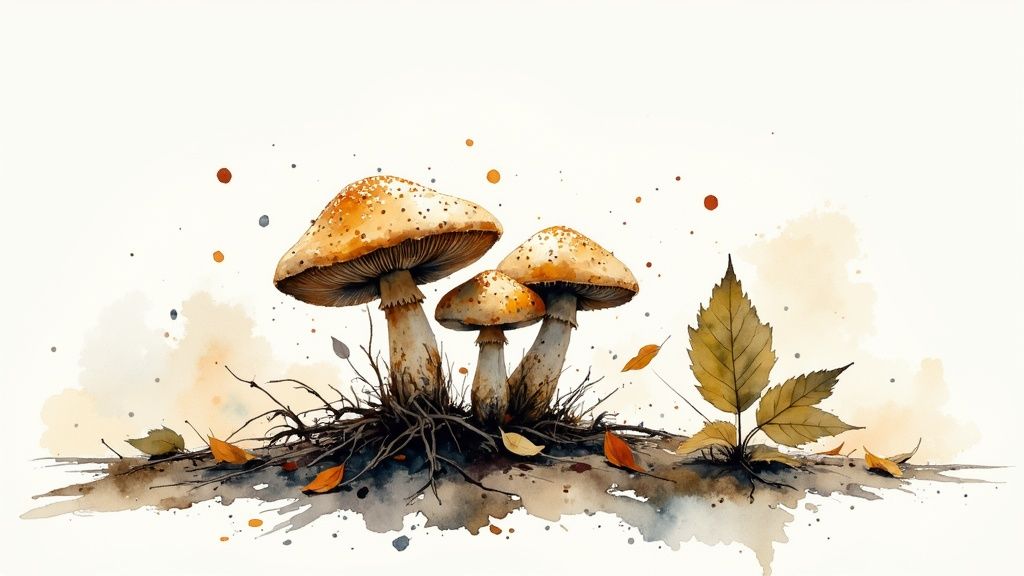
Temperature is the other piece of the puzzle. A sudden cold snap after a warm, wet period can often trigger a massive fruiting. Pay close attention to the seasons, too. Spring is primetime for morels, while summer and fall bring waves of chanterelles, boletes, and countless others. I recommend keeping a simple foraging journal to track weather patterns and what you find—you'll be surprised how accurately you can start predicting future flushes.
The Easiest Way to Find Mushrooms: Buy from Trusted Vendors
While the call of the wild and the thrill of foraging are undeniable, it’s a path that demands serious dedication, a lot of time, and a healthy respect for the risks involved. Let's be honest, for most of us, the smarter and simpler answer to finding mushrooms is to let the experts handle it.
Buying from a trusted, specialized vendor completely removes the guesswork and danger from the equation. It just makes sense.
This approach gives you something priceless: peace of mind. Every product you get is guaranteed to be exactly what it claims to be, often backed by lab testing for purity and consistency. There’s zero risk of a dangerous misidentification, no need to spend hours buried in field guides, and no questions about quality.
Guaranteed Safety and Quality
When you purchase from a reputable source, safety is the number one benefit. These vendors have stringent quality control processes locked down, ensuring their products are not only correctly identified but also totally free from contaminants. As a beginner, that level of assurance is simply impossible to achieve on your own.
On top of that, the quality is remarkably consistent. Foragers are at the mercy of Mother Nature—weather, season, and location all have a huge impact on the quality and availability of wild mushrooms. A trusted vendor, on the other hand, provides a reliable supply year-round, so you always know exactly what you’re getting.
Unmatched Variety and Convenience
Beyond safety, buying from a vendor opens up a world of variety that foraging just can't match. You suddenly have access to a huge array of mushroom products that go far beyond what you could ever find in your local woods. This includes everything from precisely dosed microdose capsules and potent tinctures to gourmet-quality infused edibles.
Buying from a vendor isn't taking a shortcut; it's choosing a path of guaranteed safety, quality, and convenience. It allows you to focus entirely on the benefits and experience, eliminating the stress and risk of the hunt.
The commercial cultivation of mushrooms has exploded into a massive global industry, making an incredible variety of fungi accessible all year. In 2023, global mushroom production soared past 40 million tonnes—a massive leap from just 0.5 million in 1961. This incredible growth, driven by advanced cultivation techniques, ensures that high-quality mushrooms are more available than ever. You can dig into these global mushroom trends and statistics on Market.us.
Ultimately, purchasing from a specialist like The Magic Mushroom Delivery is the most reliable way to find high-quality mushrooms. It’s a straightforward solution that puts your safety first and provides access to a curated selection of premium products, delivered discreetly to your door.
Common Questions About Finding Mushrooms
As you start digging into the world of fungi, having questions is a great sign. It means you're taking this seriously, and that's exactly the right approach. Whether you're thinking about foraging for the first time or just want to be a smarter buyer, getting the basics down is what separates a good experience from a bad one. Let's tackle some of the most common things people ask.
What Is the Most Important Rule of Foraging?
There's one rule that stands above all others, and it's not one you can bend: you must be 100% certain of a mushroom's identification before it even crosses your mind to consume it. This is the absolute, non-negotiable foundation of safe foraging.
It means checking your find against multiple, trusted sources. Don't just rely on a single picture in a book; cross-reference it with a good regional field guide, look it up online from reputable mycology sites, and if you can, get an expert to weigh in.
There's a classic saying for a reason: "When in doubt, throw it out." No mushroom on earth is worth risking your health, period.
Can I Learn Just from Books or Apps?
Books and those fancy new identification apps are fantastic tools, but they're just that—tools. They should never be your only resource for learning. Photos and descriptions can't capture the subtle nuances of texture, smell, or how a mushroom feels in your hand.
The best way to learn, hands down, is to find an experienced mentor or join a local mycological society. Nothing beats in-person, hands-on guidance from someone who can show you exactly what to look for. As you're learning the mushrooms, it's just as important to learn the rules. Regulations can be tricky, and you can get a better handle on the legal landscape surrounding certain mushrooms in our detailed guide on Are Magic Mushrooms Legal?.
Should I Cut or Pull Mushrooms?
You'll hear passionate arguments from both sides, but the most accepted and ethical practice is to cut the mushroom cleanly at the base of its stem with a knife.
This method leaves the delicate, web-like mycelial network underground completely undisturbed. That network is the true organism, and leaving it intact allows it to keep producing more mushrooms for years to come. As a bonus, it also keeps your harvest a lot cleaner by leaving most of the dirt behind.



